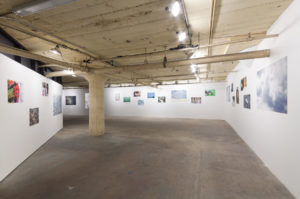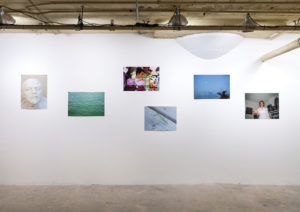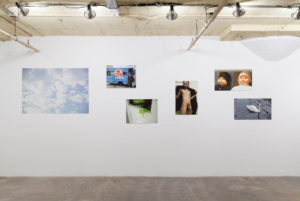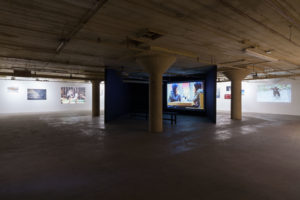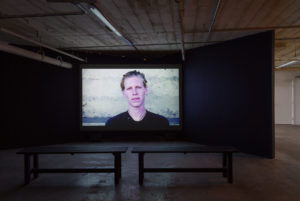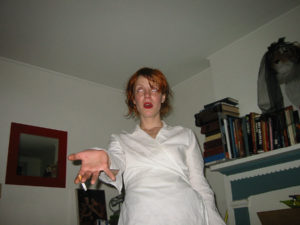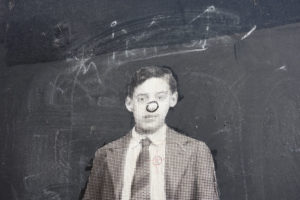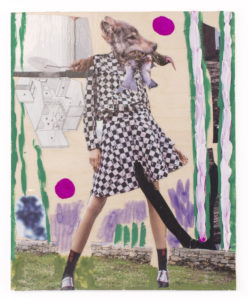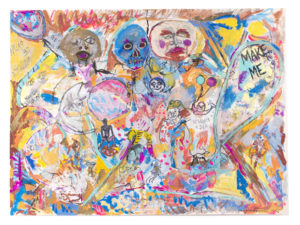Gary Indiana
- Gary Indiana in conversation with Lia Trinka-Browner, October 2015
On the occasion of Gary Indiana’s solo exhibition at 356 S. Mission Road
Lia Trinka-Browner: I first read Let it Bleed when I moved to LA in 2004 for grad school. I love this book of essays and I’ve been reading much of your work since. Most people know you more for your writing and criticism and I just started your newest book, a memoir called I Can Give You Anything But Love, which is fascinating so far… although I’m only 50 pages in. When did you start making photographs and videos?
Gary Indiana: I actually started making video before I published anything. I mean years before I published anything. It’s in the book actually. I got involved in a project with the first people that got the Sony Portapak were doing. This is when I was living in San Francisco. I mean, even though I wasn’t very much handling the equipment, I was really familiar working with video from the time I was 19. With taking photos, I have a very sporadic and weird relationship to that. You know, I know how to be a real photographer. I know how to shoot 35mm and how to develop negatives. I know how to do all that, and I did do that for years, but not very often because I didn’t have any money. And what I used to do for years was I would just take pictures and then I would take the exposed roll of film and throw it into a shoebox. At some point in the late 80’s when I actually had some money, I just started grabbing handfuls of these ancient camera rolls and getting them developed and there were pictures that I had taken with every imaginable kind of camera. And then digital cameras came in and then that was easier, although the prints and stuff was terrible at first, but suddenly it was cheap to take photos. In one-way or another, I’ve been taking photos for 30 years at least, but not as a profession.
LTB: Do you consider yourself a photographer?
GI: No, not at all. I mean, I don’t even believe in it as an art form to be honest. I don’t. I think maybe it was at one time. Not everybody could take a photo and just have it. But now everybody can and there are too many images in the world. I think now if you’re going to deal with photography you should use it for something. Anyways, I never could stand the whole Ansel Adams, palladium print thing. I just never got it. I thought, if that is art then it’s really minor art.
LTB: Your photographs are almost like “snapshots” and that there’s doesn’t seem to be so much hierarchy between them. For our show at 356, we have a stingray, a Halloween mask, a large penis, and a dog, among others. They act like snapshots and there’s an almost unknown narrative, but it’s not necessarily like each photo feels particularly precious, but all together they kind of make this narrative about travel or this narrative about containment. How does the imagery fit into what you are doing and how do you view these photographs?
GI: First of all, let me say that Slim is not just a penis.
LTG: Haha! Of course not.
GI: That is a real person who I know and I really like him I would feel terrible to let you get away with just saying he’s just a penis!
LTB: Oh no…ha – I don’t think he’s just a penis!
GI: Exactly – He’s a very, very interesting man…who has a very large penis! But that’s one of my things – really interesting man with large penises. But I think of writing and making art is an inventory of your consciousness basically. If I could say anything positive about myself without blushing is that I happen to think that I have a fairly interesting and developed consciousness. And so what comes into it and what catches my attention is probably worth other people’s time to interest themselves in. If it’s something that I’ve paid attention to, then I’m obviously bringing a lot to that. So I think of myself, or I’ve always thought of myself as an artist much more than just as a writer. I don’t like the monastic idea of writing, this monkish discipline that you flog yourself over every morning. I mean that’s for people who are really pretentious. I think that you can probably read this show as a travelogue of a kind, but it’s not really about physical travel, but more mental travel. A lot of the video stuff is about statelessness – a kind of homeless consciousness or placeless consciousness. The things that defined where people were in the world have all broken down since the Second World War.
LTB: Let’s talk about Stanley Park, which is such a great video.
GI: Thank you.
LTB: It was shown at the Whitney and we’re showing it here, among other videos. It’s kind of like a meandering example of images of prison and captivity references; there’s the model prison in Cuba, there’s so many film clips and music clips that you’ve borrowed and pieced together that it’s more like a video collage. You mentioned that it was made for Werner Schroeter. Which is great and I think that a lot of people don’t know his work that well. Can you talk about your connection to him and his films?
GI: Yeah, I can. Werner and I were extremely close. I met him probably in 1980 or 1981. I can’t remember exactly what year I met Werner but I wanted to meet him for a long time. He was a tremendous influence on me. He was a great filmmaker and one of the only geniuses that I’ve ever known or one of the only people I’ve ever know that I could say was really a genius. And you know, an incredibly complex and sometimes very difficult person, but I loved him, I mean probably more than anyone in my life. I learned a lot from him. I learned how to make a good frame [in film] and I learned how to listen to opera, to Maria Callas particularly. I learned to be a better person though Werner, even though I mean, he could be a piece of work himself, but I owe so much to him and his memory. A lot of the things in Stanley Park are really kind of private in a way to people that know about Werner, because some of the soundtrack is from Werner’s films. The clip from Touch of Evil – basically because Werner said the only two things in the cinema that had an effect on him was Falconetti in Dreyer’s Joan of Arc and that shot of Marlene Dietrich coming out of the kitchen. He wasn’t a cineaste. He wasn’t that interested in movies. He was totally interested in beauty and love and death and things of ultimate importance. I learned a lot from Werner about what isn’t important in life. He had a much more operatic sensibility than I do. He could be much more florid than I can. For one thing he was directing films, and he was directing operas and I wasn’t doing that. But I really meant the film as a way of saying goodbye. I went into a very bad state after he died for about 3 years. And then at some point I was just like, you have to let it go or at least say goodbye in a nice way. You know Ingrid Caven is on the soundtrack…
LTB: Yes, she’s fantastic – that book by Jean-Jacques Shuhl, Ingrid Caven, is so great as well.
GI: Yes, these are very close friends of mine and we all miss Werner a lot. He was just one of those special people that you meet in your life and they change your life, they just do. I’ve had the luck to have a few people like that.
But Werner was definitely the most important.
LTB: Moving onto something lighter…
GI: I know, we can get into some heavy things – but he was the love of my life, no question.
LTB: Your movie Soap is a video that is just about soap. Your writing and your artwork has this element of being so intensely emotional and serious but also extremely funny. There are a lot of different emotions that are in play with your work. I don’t know if that’s a question or not. I guess can you talk more about Soap?
GI: Soap was inspired by this book by Francis Ponge, which appeared during the Nazi occupation of France. At that time, the French were consigned to using, I mean of course this is now luxury soap, but at the time, it was practically just a hunk of lard. It was called Savon De Marseille. Everyone hated this soap because it had no lather. This is what the Germans let the French have. This whole kind of wonderful thing, which is partly a prose poem and partly a radio play that Ponge did was ingenious, because the French received it in one way and the Germans in a completely different way because they didn’t get that this was about them, about the occupation. They didn’t get it at all and just thought it was some poet being frivolous and talking about soap. But it was about something very serious. My thing with that is that I love this book very much also because it’s a real decoupage of forms, it’s partly this and that, it’s a bit poem, it’s a bit of a prose piece and radio plays and philosophical speculation and everything you could say about soap, so I just wanted to do something where I just got people to talk about soap. I didn’t want to make a narrative, but I wanted to find something that most people have familiarity with – something part of their lives: soap. Everybody uses soap so I just asked people to tell me a story about their relationship to soap. And people came up with the most incredibly diverse things.
There was stuff that didn’t get into it because it was done later. Jesse Friedman from Capturing the Friedmans told me this story about soap. When he was in prison – at the point where New York State started taxing cigarettes so high, cigarettes stopped being the medium of exchange in the prison, because they became so outrageously expensive. He said people started exchanging soap, luxury soap, and anyone who had money or who had connections on the outside or people who were helping them, would get them to buy these luxury soaps. He said that in the prison, he said “we made everything ourselves.” They made the state pajamas, state uniforms and state soap, which was terrible and completely without any nice soap qualities. The guy in the cell next to him had collected hundreds of boxes of different luxury soaps and so he glued them to the walls of the cell and there was this wonderful fragrance as you walked by.
LTB: That sounds beautiful actually.
GI: And I said, well what did you do with the state soap? And he said, after lockdown, if you wanted to get anything to a prisoner who’s further down the row, then you use a fishing line and you have to hold it outside the cell and throw it and you have to have something to weigh it so it doesn’t go flying and that’s what we do with the soap – they use it as a weight to throw this stuff. So he said in the morning when they opened the cellblock, the whole floor was covered with state soap. Certain things like that I hoped that I could incorporate later, but never got around to it. Anyway it was not shot in HD and there was no point in continuing that format.
LTB: The last thing I wanted to talk about is the gifs that you’ve been making. I only just started seeing them, but I think they are so interesting with the show and what you’re doing that maybe you could talk about those a bit?
GI: Well, I don’t know what to say about them, except that I didn’t realize that you could make them.
LTB: Right, there’s a readiness and availability of making them. You can just go online and easily make them.
GI: Yeah! I mean I downloaded this app because I’ve been seeing these gifs for years. I don’t know why, but anything that I don’t know how to do myself, I just think that it’s magic. Then when I found out I could just download this app and make them, and then I just started to really get into making them. Because I love anything interesting you can do with images. I’m not a photographer, but I am an image-maker. I love working with images, I love manipulating them, I love making them turn on themselves and this is another way to do it. I think Dennis Cooper has written a whole novel in the form of gifs. I don’t know how exactly you would do it, because haven’t see it, but I’m sure it’s wonderful. I mean it must be really interesting. And I thought, oh I can do something with that. I won’t write a novel that way, but I can do something interesting with that and I think it would be fun because it’s also great for the modern attention span.
LTB: Totally. Yes!
GI: I’m a great believer in not being like Jonathan Franzen and people like this who just obdurately hates technology – you know what go back to a cave, because this is where we are. You have to adjust. If you’re going to communicate with people you have to communicate in a way they are going to be receptive to. I have no problem with that, you know? I have no problem with making a 5 second film. I have no problem with it at all! Because I have the attention span of everyone else, I pretend that I don’t but…
LTB: Sure, we all do! It’s true.
GI: You can receive a lot of aesthetic pleasure and information in like 5 seconds or 10 seconds. It doesn’t have to go on for eternity. Anyway, I prefer something light over Wagnerian.
- Select Reviews"One film shows a man in a black shirt walking back and forth obsessively, looking disturbed and unkempt. Watching this feels voyeuristic, but there’s tenderness in Indiana’s treatment of his subjects. The show resembles diary excerpts, a record of things that moved the artist." – Catherine Wagley for The LA Weekly, November 2015
-
Unveiled: A Symposium on Gary Indiana
October 11, 2015

